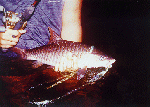



 Kelah
Kelah
Cyprininae, Tor tambroides. Also known as the Malaysian Mahseer. Also known as the Malaysian Mahseer, this hard fighting fish is considered the king of freshwater sport fish in Malaysia by many anglers! Just the mention of this fish will bring out reminisces of previous expeditions and the dreams of anglers yet to catch a kelah. This member of the carp family is well muscled and protected with large golden scales, as its habitat is the fast rocky rivers. The environment it lives in accounts for the power and tenacity of the fish when hooked up! Many an angler has lost the kelah due to its powerful runs into snag territory! Submerged timber the most common type of snag found in the rivers. These old tree trunks and branches washed down during flash floods. The kelah is found in our clean waters in many of the major rivers that are still unpolluted by man. The rivers in our national parks and those feeding Kenyir Dam and Temenggor dam are just some of the rivers known to hold kelah. Smaller rivers in the other states have kelah too. During the day kelah can be found lurking in the deep holes in the rivers. Placing a suitable bait there may entice it to bite. When night falls the kelah will leave its daytime haunts to feed in the shallow. It looks for food in the shallow waters and below the rapids. One can hear it actually turning over rocks looking for a tasty morsel! Thus fishing for kelah at night requires slightly different tactics. As kelah gets spooked easily, stealthy tactics are the way to go! Most kelah experts recommend very quiet movements and little light used at night. They usually fish alone as talking to a buddy might spook the fish. Kelah take a wide variety baits, but the most common are palm oil seeds and tapioca roots (ubi kayu). The palm oil seeds are obtained from remnants of harvested palm oil seeds found at the palm oil plantations. This oily seed can be used whole for large quarry or strips of its fibrous flesh used for the smaller fish. The use of ripe seeds are the best as it has a lot of oil (and smell). If it is overripe it is soft and doesn't hold well on the hook, under ripe it is very hard and doesn't hold as much oil. Tapioca roots that are slightly "rotten" are the best as it produces a strong aroma! The tuber is cut into cubes, a slit made in it and the hook buried in the slit. The size of the cube of tuber used varies from river to river. In some rivers the kelah will take tiny tapioca baits one centimetre square, in other rivers larger pieces are preferred. When the river is high and muddy due to heavy rains, bait like grubs or worms are preferred (these are the sort of food found washed into the river due to the rains). Large freshwater prawns found beneath the rocks in the river make good baits too. Natural forest fruits or nuts (neram, maris, ara, buah mata lembu, buah perah & jambu air) that are found by the river are extremely suitable baits during the appropriate fruit season. The kelah mouth/throat is very, very strong, to eat these hard natural foods. Many an angler has found the treble or single hook mangled up and returned! (Minus the fish of course!) Kelah do take lures like spoons and spinners on occasion too, but most anglers prefer to fish with bait. Ground baiting the day before fishing is important to increase the chances of catching kelah. Generally the best way of keeping crushed palm oil seeds or tapioca in the spot is to place the ground bait in a gunny sack weighed down with stones. The enticing smells will drive the kelah wild! Kelah grow in excess of 10 kilos but the 2-3 kilo range is considered satisfactory. It is also a delicious fish, very highly prized for its eating qualities. Not only that but the large scales are edible too! This fast disappearing fish is a treasure to anglers here and should be conserved. Catch and release is the only way to enjoy its fighting qualities and still preserve this fish in our waters! |